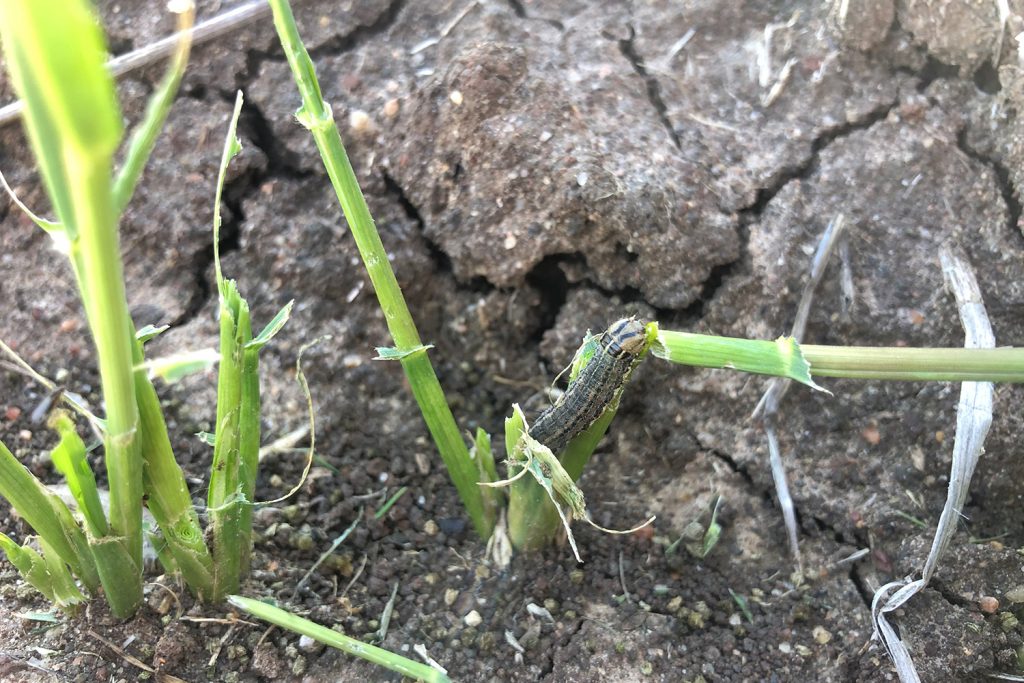Armyworm larvae have been reported in cereals in several areas of south-eastern Australia and two of the biggest questions are, how long will current populations stick around, and will they be a head-lopping risk?

Photo by Stuart McColl 
Photo by Stuart McColl
One name, (at least) three species
Armyworm is a catch-all common name for several crop and pasture moth larvae spanning temperate, sub-tropical and tropical species.
In south-eastern Australian winter cereals, armyworm populations are likely to be native species; either the common armyworm (Mythimna convecta), the southern armyworm (Persectania ewingii) or the inland armyworm (Persectania dyscrita).
At the larval stage, these species are difficult to tell apart and correct species identification in the field is generally not critical because their habits, type of damage and control are similar.
The occurrence of multiple species in south-eastern Australia means that armyworm can migrate into paddocks year-round and therefore they can be found at all stages of crop development.
Armyworm head lopping risk
Native armyworms can lop cereals heads right off, but it is more likely to happen during the overlap of two conditions.
1) The crop is drying off
When a crop is drying off armyworm larvae can chew through the stem just below the head causing heads to be lopped and fall to the ground. This is more likely to happen when this stem area is the last green material left on the plant.
2) Large larvae are present
Large larvae are most likely responsible for headlopping. This could be because armyworm do the majority of their feeding and are more voracious as they reach maturity, and they have bigger jaws for chewing than smaller grubs.
Also note that wheat and triticale have thicker stems and are less susceptible to head loss than barley, while oat is likely buffered from significant damage as they have multiple panicles.
When will armyworm pupate?
If you have armyworm in your cereals at the moment, it is important to factor in expected pupation dates, since it is at this point that the risk from mature larvae will cease.
We can use a model that simulates the development times of the common armyworm and the southern armyworm using 5-year averages of temperature data.
Using this model, we estimate when you could expect current populations to stop eating crops and pupate in key cereal growing regions of southern NSW and Victoria (see below). We don’t expect that you will distinguish between the two species in the field; we can provide both development times to provide a date range.
Armyworm go through 5-6 larval stages (‘instars’) before pupating and eventually emerging as a moth. You can estimate the life-stage of armyworm larvae by measuring their length with a ruler (3rd instar: 7 – 16 mm, 5th instar: 18 – 30 mm).
Remember, these armyworm species are highly migratory. When current populations reach maturity, they are more likely to fly away rather than stick around and generate more larvae in the same location.
Contact us to access the model.
Monitoring armyworm
Armyworm larvae are most active at night, seeking shelter under debris and vegetation on the ground during the day.
This means that monitoring with a sweep net during the day is not the best way to assess the number and size of larvae within a crop.
Instead, do a direct ground search along with sweep netting (preferably in the evening).
Identification tip: Remember the give-away feature of an armyworm is the 3 white stripes on the collar behind their head, which can sometimes extend down the length of their body.
This season armyworm larva (most likely inland armyworm) were found lopping a few lentil branches in the Victorian Mallee. The damage was isolated. The armyworm species that occur in south-eastern winter cropping season prefer cereals and grasses. They aren’t expected to cause a lot of damage in lentils, although occasional branch lopping is not unheard of.
Keep in mind there other caterpillar species around at the moment in crops including herringbone caterpillars (Proteuxoa sp.), brown pasture looper (Ciampa arietaria) and pasture day moth (Apina callisto).
For more information on armyworm including identification, control and behaviour visit PestNotes Southern.


In the same region near Yerong Creek, a paddock of lupins had significant damage in patches where the larvae had stripped the leaves bare. Photo by Andrew Weeks, Cesar Australia
Acknowledgements
Thanks to the following for providing field observations: Stuart McColl (Kagome), Matt Bissett (Agrivision), Daniel Andrews (Nutrien Ag), Darcy Bullen (Western Ag), Andrew McMahen (Nutrien Ag), Heidi Gooden (Delta Ag).
Cover image: Photo by Julia Severi, Cesar Australia





